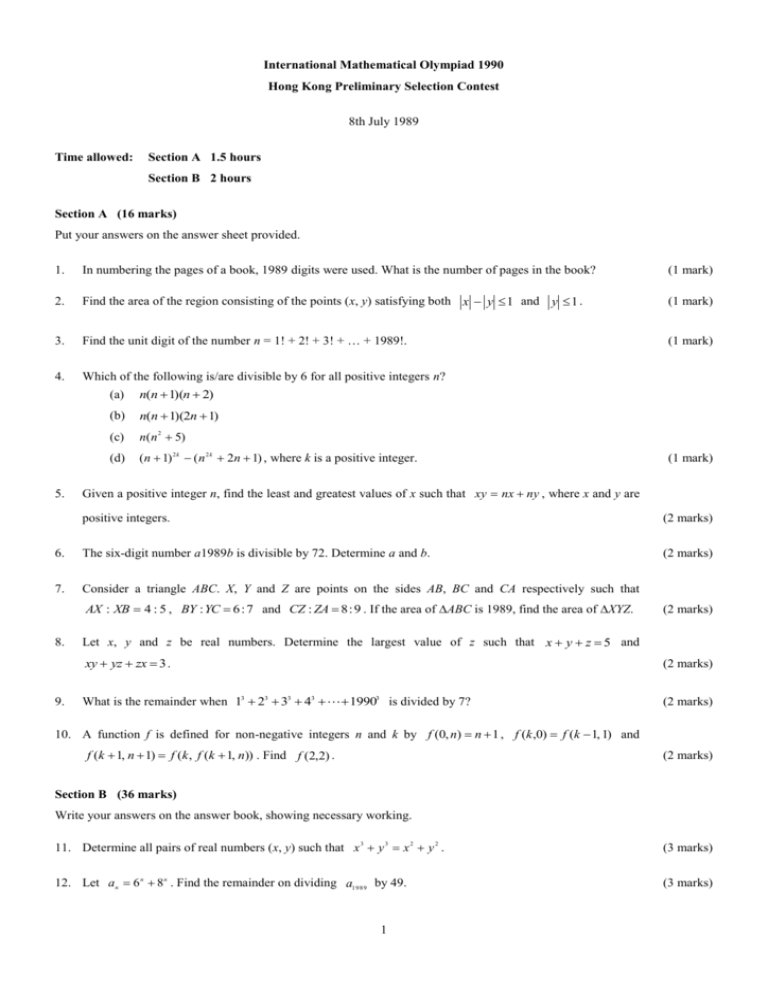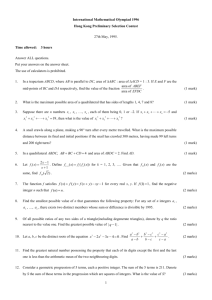5. IMO 1990 Hong Kong Preliminary Selection Contest
advertisement

International Mathematical Olympiad 1990
Hong Kong Preliminary Selection Contest
8th July 1989
Time allowed:
Section A 1.5 hours
Section B 2 hours
Section A (16 marks)
Put your answers on the answer sheet provided.
1.
In numbering the pages of a book, 1989 digits were used. What is the number of pages in the book?
(1 mark)
2.
Find the area of the region consisting of the points (x, y) satisfying both x y 1 and y 1 .
(1 mark)
3.
Find the unit digit of the number n = 1! + 2! + 3! + … + 1989!.
(1 mark)
4.
Which of the following is/are divisible by 6 for all positive integers n?
5.
(a)
n(n 1)(n 2)
(b)
n(n 1)(2n 1)
(c)
n(n 2 5)
(d)
(n 1) 2 k (n 2 k 2n 1) , where k is a positive integer.
(1 mark)
Given a positive integer n, find the least and greatest values of x such that xy nx ny , where x and y are
positive integers.
(2 marks)
6.
The six-digit number a1989b is divisible by 72. Determine a and b.
(2 marks)
7.
Consider a triangle ABC. X, Y and Z are points on the sides AB, BC and CA respectively such that
AX : XB 4 : 5 , BY : YC 6 : 7 and CZ : ZA 8 : 9 . If the area of ABC is 1989, find the area of XYZ.
8.
9.
(2 marks)
Let x, y and z be real numbers. Determine the largest value of z such that x y z 5 and
xy yz zx 3 .
(2 marks)
What is the remainder when 13 23 33 43 19903 is divided by 7?
(2 marks)
10. A function f is defined for non-negative integers n and k by f (0, n) n 1 , f (k ,0) f (k 1, 1) and
f (k 1, n 1) f (k , f (k 1, n)) . Find f (2,2) .
(2 marks)
Section B (36 marks)
Write your answers on the answer book, showing necessary working.
11. Determine all pairs of real numbers (x, y) such that x 3 y 3 x 2 y 2 .
(3 marks)
12. Let an 6 n 8 n . Find the remainder on dividing a1989 by 49.
(3 marks)
1
A
13. In the figure ABC is an isosceles triangle with a vertical angle of 20. A point
D is marked off on AC such that AD = BC. Find ABD.
20
D
B
C
14. Show that the area of a triangle of fixed perimeter is maximum when it is equilateral.
(3 marks)
(3 marks)
15. Let S (n) be the sum of the first n terms of the sequence 0, 1, 1, 2, 2, 3, 3, …. If x and y are positive
integers with x y , show that S ( x y) S ( x y) xy .
(4 marks)
16. Show that the roots of the equation a0 x n a1 x n1 a2 x n2 an3 x 3 x 2 x 1 0 with real coefficients
cannot be all real.
(4 marks)
17. The sides BC, CA, AB of ABC are produced to D, E and F respectively such that CD = AE = BF. If DEF
is equilateral, show that ABC is also equilateral.
18. (a)
(4 marks)
Let rn and Rn be respectively the radii of the inscribed circle and the circumscribed circle of a
regular 2 n -sided polygon of perimeter 1. Prove that
Rn rn
, and
2
(i)
rn 1
(ii)
Rn1 Rn rn1 for
n 1.
(b) Consider the sequences {a n } and {bn } such that a1 0 , b1
a bn
1
, an1 n
2
2
( n 1 ) and
bn1 an1 bn ( n 1 ). Find lim an and lim bn .
n
n
(4 marks)
19. The sequence of digits
12345678910111213141516171819202122…
is obtained by writing the positive integers in order. For any positive integer n, if the 10n th digit in this
sequence is in the part of the sequence in which an m-digit number is placed, define f (n) to be m. For
instance, f (1) f (2) 2 since the 10th and the 100th digits enter the sequence in the placement of the
2-digit numbers 10 and 55, respectively. Find, with proof, f (1989 ) .
END OF PAPER
2
(8 marks)







